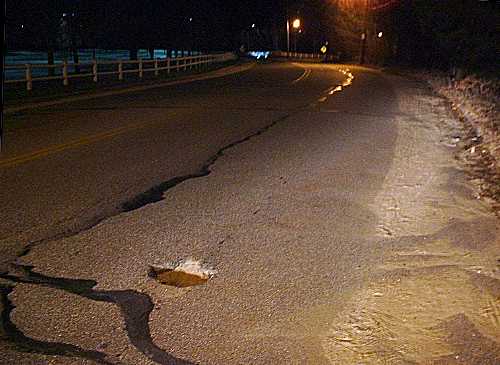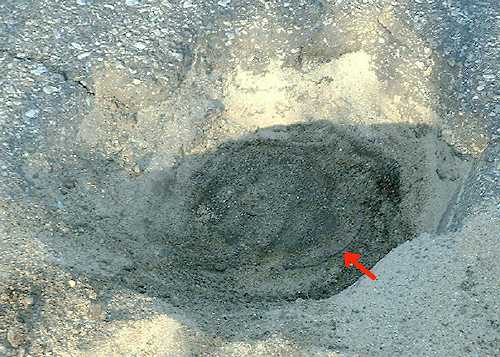
Top: Home Page
Up: Table of Contents
Previous:
Next:
| West Street, Waltham, Massachusetts, about 200 yards south of Winter Street, 8:45 PM,
Saturday, April 16, 2005. A group of bicyclists has just entered from a parking lot on the
east side of the street and is headed south. The ride is part of a training for League
Cycling Instructors, and all of the bicyclists have lighting equipment. There also are
overhead streetlamps. The street has been repaved recently and the pavement is smooth. I am a co-instructor, second in line, behind the lead instructor, Charley LaFlamme. I look for a second into my rear-view mirror and then, clunkclunkclunk, the handlebars fall and twist out of my hands. Next thing I know, I am standing and Charley says to the other co-instructor, Paul Schimek, "Paul, how about you go back with John to the classroom and we will finish the ride and come back later?" Paul and I walk back to the classroom, where we sit and wait. We decide that Paul should drive me home with my bicycle in his car. The classroom is familiar enough, but when Paul asks me for directions, I have no idea how to get home -- I, who surveyed routes for the state bike map. I take off my helmet and look at it. There is quite a scrape at the right front. I also look at my elbow. There is a scrape with an orange liquid painted on it. Paul tells me that Ralph Sturgen, an instructor candidate and an EMT, put betadine antiseptic on the scrape. I don't remember anything about this. There is a betadine swab clamped into the rear rack of my bicycle. The ride returns and Ralph flashes his LED bicycle headlamp into my eyes. I pass his inspection. I stand up in front of the class and we have a "teachable moment." I show the class my helmet and explain, as if I had to, why we wear helmets. Charley says that he feels guilty for having pointed out the pothole but not called it out. I tell him that's OK. Paul and Charley tell me that I don't have to return to help the class the next day if I don't feel like it. Paul and I leave the classroom and put my bicycle into his car. We drive to the location of the crash. I get out of Paul's car and take a photo of the pothole by the light of the headlamps. Winter sand still lines the road and the pothole is in the typical path of travel of a bicyclist. This is no ordinary pothole. There are several flat, nearly vertical sections in its walls. It appears to have been dug out with the blade of a jackhammer. |
The pothole as I saw it by the light of Paul's headlamps.
Note the sand swept away to the right of the pothole -- that is where I fell.

| When I get home, Paul offers to take me to the hospital, but I tell him that he can go
back home to be with his lovely fiancée. I can take a taxi to the hospital if the doctor
on call thinks that I need to be seen. My wife is at Fenway Park to watch the Red Sox play the
Toronto Blue Jays. I turn on the radio in the kitchen and the Red Sox are winning. I will
wait till my wife gets home to tell her about my crash -- there is no sense in ruining her
fun.
The doctor tells me that if I go to the hospital, I probably will sit in the emergency room for three or four hours, and that I may stay home. My sense of direction is returning -- I can already remember how to get back to the classroom location. I phone Paul and tell him that I probably will help with the class the next morning. The next day is my 59th birthday. The class has a nice card, a book -- David Herlihy's Bicycle -- and a bicycle saddle for me. Charley smiles and claps me on the shoulder. "I landed on that shoulder," I tell him, and smile. It doesn't really hurt. I get a laugh from the class, and Charley apologizes profusely. Later, I ask him how much time elapsed between my fall and my return to the classroom. "Ten to 15 minutes," he tells me. "You were dusting yourself off, acting normally enough. Ralph cleaned your elbow. and put betadine on it. He shined his light into your eyes." I remember none of this. Instructor candidate Michael Hurst tells me that he is glad that had practiced the quick turn earlier in the day, so he could avoid running over me. After the day's work is over, I go back and look at the pothole again. I scoop out sand with my gloved hands and find a water valve 5 inches below the surface of the pavement. Let this be a quick lesson in accident investigation work. If you dig, you might find something. |
The pothole after I scooped out the sand. The red arrow
points to the circular outline of the water valve.
Note the straight cut at the right side of the picture.

| The street had been repaved, probably more than once, without raising the water valve.
Then, the hole had been dug out with a jackhammer to provide access to the valve. When
access wasn't needed anymore, the hole had not been filled in. There just aren't enough potholes in Waltham in the spring of 2005. The City had to make another one on this street which didn't have any. And thanks to that pothole, my bicycle helmet has a flat spot and there are 10 or 15 minutes missing out of my life. Could have been worse, though. Another doctor gave a presentation on bicycling medicine at the Bicycling Education and Leadership Conference in New York two weeks after my crash. One thing I learned there was that it is best to avoid doing things that might bang your head again for a few weeks after suffering a concussion. Another impact during that time period carries the risk of more serious problems. I was then two days past having ridden 45 miles in the 5-Boro Tour, a zoo of a ride with 35,000 participants, many of whose skills were less than superb. |